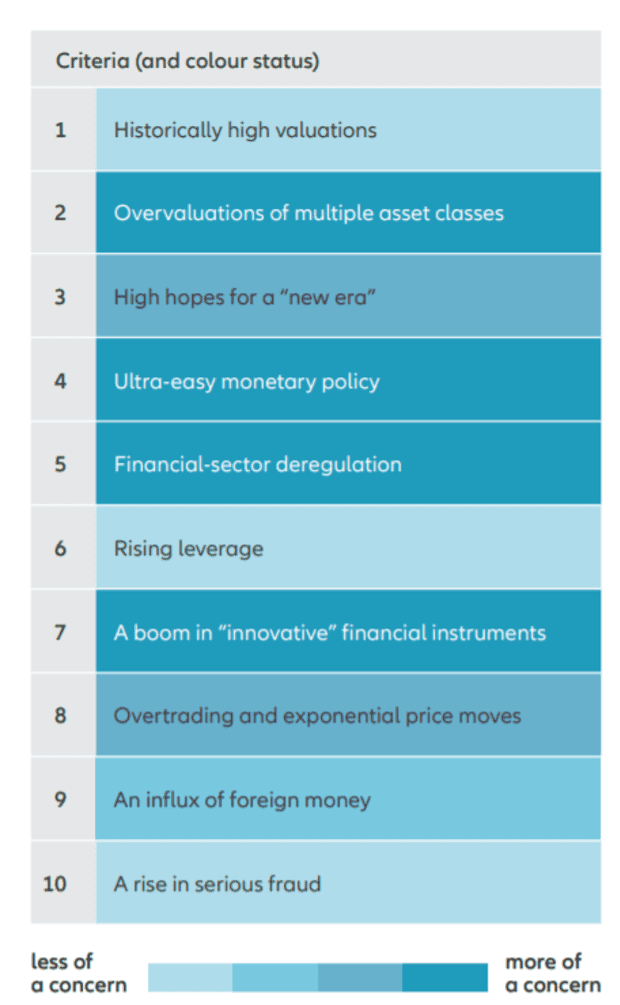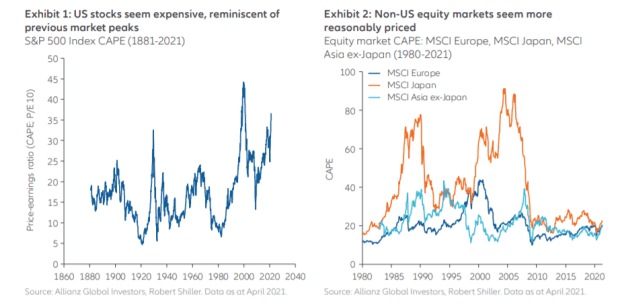U.S. stocks are demonstrating most of the characteristics of a bubble, but don’t sell yet, says strategist
The old investment adage is, “sell in May and go away,” but this year, investors just seem to have done the latter — the S&P 500 has moved all of 0.2% higher during the fifth month of the year. So it’s a good time to step back and look at the bigger picture for stocks.
Stefan Hofrichter, head of global economics and strategy at German fund management giant Allianz Global Investors, put together a 10-point checklist for bubbles that he says was inspired by Charles Kindleberger, the author of the 1978 classic, “Manias, Panics, and Crashes.” In the table below, you can see what that list is, as well as the color-coded rating he assigned to them.

At the end of April, the S&P 500 SPX,

Also on the bubble list is that multiple asset classes are overvalued, noting that the term premium for longer-dated sovereign bonds remains around 100 basis points below the long-term average. Another sign of bubbles is that they tend to occur alongside the perception of a new era, which clearly is the case now with artificial intelligence. Ultra-easy monetary policy, the advent of new financial instruments like special-purpose acquisition companies and cryptocurrencies, and what he calls “overtrading” — exponential price movements and signs of above-average risk taking — also are illustrative of bubbles.
So with all these bubble signs, isn’t it a time to sell? “History has shown that bubbles only burst once central banks start to hike rates or take other steps to rein in their ‘easy money’ policies.” Until the Fed starts tapering its bond purchases, “we think there is a reasonable chance that U.S. equities will continue bubbling up further. As a result, we stay nervously ‘risk on’ for now, gravitating towards risk assets. And we have a bias for value stocks, which are trading at a multidecade discount to growth stocks,” he says.
Subtle shift at the Fed
Tim Duy, chief U.S. economist at SGH Macro Advisors, analyzed the wave of comments from Federal Reserve officials, including Vice Chair Richard Clarida. “Notice how slowly the Fed is moving in the tapering direction, mixing in talking about tapering with policy still being in a good place and not seeing substantial progress ‘just yet.’ This is by design. It’s enough that if you are watching for it and you know what to look for, you see the subtle shift but not enough to be any kind of game-changer,” he said. Duy expects the formal pivot toward tapering to be announced at the Jackson Hole, Wyo. conference in August, with the actual reductions starting in the first quarter of 2022, or possibly the final quarter of 2021.
Fed Vice Chair for Supervision Randal Quarles has two speeches, the first on insurance regulation and the second on the economic outlook.
The chief executives of Wall Street banks — including Bank of America BAC,
Read: Big bank CEOs to be grilled on diversity and woke capitalism.
Dick’s Sporting Goods DKS,
After the close, graphics chip maker Nvidia NVDA,
Bitcoin reclaims $40,000 level
U.S. stock futures ES00,
Bitcoin BTCUSD,
Random reads
How parking requirements ruin cities.
A new reality-television series will offer the chance to become an astronaut.
Need to Know starts early and is updated until the opening bell, but sign up here to get it delivered once to your email box. The emailed version will be sent out at about 7:30 a.m. Eastern.
Want more for the day ahead? Sign up for The Barron’s Daily, a morning briefing for investors, including exclusive commentary from Barron’s and MarketWatch writers.




